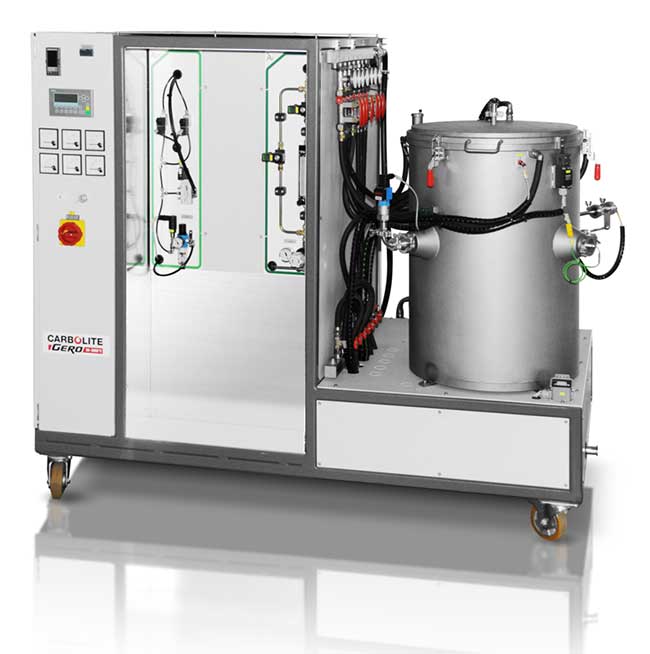Carbolite LHTM/W Metal Insulation Laboratory Furnace
The Carbolite LHTM/W Laboratory Furnace is a compact design, making it the perfect tool for laboratories in research and development environments.
The cylindrical usable space of the laboratory furnace is surrounded by the heating elements and insulation material. The heated chamber is integrated into the water cooled vessel. As a result of the small volume, the LHT is ideal for small samples and requires minimal operating space.
The system is supported by a single frame platform which supports the furnace and electronic cabinet containing the software controls. Casters are attached to the supporting platform, which allows the whole system to move easily. For universities and industrial research laboratories, the LHT series is a perfect fit for such operating areas.
Key Features
- Compact design suited for laboratories
- Best possible vacuum
- Vacuum level < 5 x 10-6 mbar
- Partial pressure 10 – 1000 mbar
- Overpressure operation up to 100 bar possible
- Hydrogen partial pressure operation on demand
- Precisely controlled vacuum pumping speeds appropriate for use with powders
- Data recording for quality management
The small overall dimensions and simple operation result in a cost effective system without any performance loss in temperature uniformity or atmospheric quality. Additionally, the cylindrical design is best suited for overpressure heat treatment processes. Upon request, the system can be equipped with a suitable locking device and all necessary equipment for safe overpressure operations up to 100 bar.
The metallic LHT models are based on heating elements and radiation shields constructed of tungsten or molybdenum for a maximum temperature of 2200 °C and 1600 °C, respectively. The radiation shields serve to insulate the heat of the heating elements from the water cooled vessel. The metallic LHT systems provide the highest possible atmospheric purity and best final vacuum level. With a turbomolecular pump in combination with a pre-pump, the working vacuum can reach the high vacuum region. An ultra high vacuum configuration is possible upon request.
Application Examples
annealing, brazing, carbonisation, ceramic injection moulding (CIM), debinding, degassing, drying, hardening, metal injection moulding (MIM), pyrolysis, Quenching, rapid prototyping, siliconization, sintering, soldering, sublimation, synthesis, tempering
The LHT models are heated by a single mantle heater because of their small volume. The temperature profile inside is better than ± 10 K. This uniformity is achieved through careful engineering and positioning of the heating element.
The LHTM and LHTW are both constructed of metallic materials and 9 radiation shields. It has a single heating zone that covers the mantle of the cylindrical vessel. The mantle heater is designed for the highest stability. Two different heating elements are available. The standard heating elements consists of several molybdenum sheets, and upon request, a mesh heater is also available. The sample can be protected by a retort that further improves temperature uniformity. With the adaption of a high vacuum system, the best final vacuum is available.
Software operation is available with manual or automated controls. For the manual version, all valves and pumps are operated by simple push buttons at the user panel with a rotameter used to adjust gas flow. The automated software is operated via a touch panel interface. Mass flow controllers are used to regulate the gas flow. Data logging is possible for both manual and automated operation.
- To order contact us via:
Phone: Call +44 (0)330 088 0560 - Email: [email protected]
- Web Form: Get a quote
LHTM 100-200/16-1G
| Insulation material | Molybdenum |
| Volume (l) | 1.5 |
| Tmax vacuum (°C) | 1600 |
| Tmax atmospheric pressure (°C) | 1600 |
LHTM 200-300/16-1G
| Insulation material | Molybdenum |
| Volume (l) | 10 |
| Tmax vacuum (°C) | 1600 |
| Tmax atmospheric pressure (°C) | 1600 |
LHTW 100-200/22-1G
| Insulation material | Tungsten |
| Volume (l) | 1.5 |
| Tmax vacuum (°C) | 2200 |
| Tmax atmospheric pressure (°C) | 2200 |
LHTW 200-300/22-1G
| Insulation material | Tungsten |
| Volume (l) | 10 |
| Tmax vacuum (°C) | 2200 |
| Tmax atmospheric pressure (°C) | 2200 |





